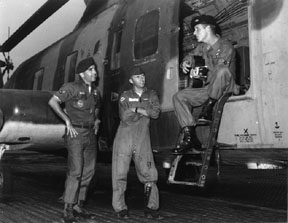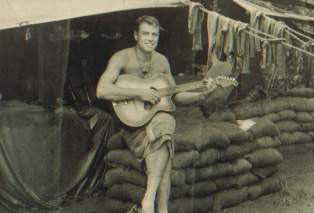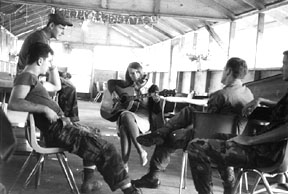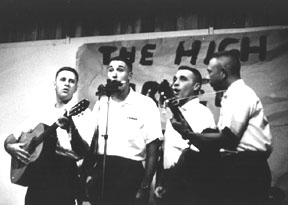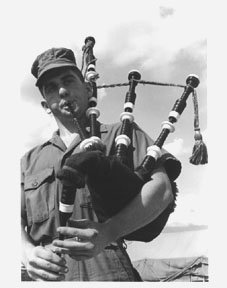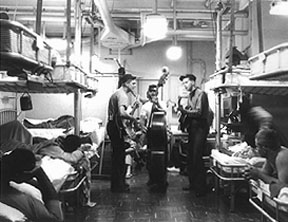SOURCES
CITED
Allen, George. 1988. Interview by author, 13 July.
Bullington, James. 1985. Interview by Steve Brown and Cynthia Johnston,
17 September.
Les Cleveland. 1988. "Voices From the Frontlines: Soldiers' Songs
As Occupational Folklore." Lecture at the National Museum of American
History, 7 June.
Del Vecchio, John. 1983. The Thirteenth Valley. New York: Bantam
Books.
Herr, Michael. 1977. Dispatches. New York: Alfred A. Knopf.
Hughes, Toby. 1989. "What The Captain Means: A Song of the In-Country
Air War." Manuscript.
Perry, Charles. 1968. "Is This Any Way To Run the Army? Stoned?"
Rolling Stone, November 9, 1968:1,6,8,9.
Rosenberg, Chuck. 1988. "Jody's Got Your Cadillac," concert
of folksongs of the Vietnam War, Albany, NY, 28 May 1988.
Sheehan, Neil. 1988. A Bright Shining Lie. New
York: Random House.
Strange, Emily. 1988. Letter to author, 21 August 1988.
Treaster, Joseph B. 1966. "G.I. View of Vietnam." New York
Times Magazine, October 30, 1966:100, 102, 104, 106, 109.
Tuso, Joseph F. 1989. Singing the Vietnam Blues: Folksongs of the
American Fighter Pilot in Southeast Asia. College Station: Texas
A and M Press, 1990.
|
******************************************************************
NOTES
The song clips on this page are taken from In Country:
Folk Songs of Americans in the Vietnam War, Flying Fish Records Inc.
(FF 70552), 1991. The songs mentioned in the text are from my own collection
or from the Lansdale tapes in the Library of Congress. The photographs are from the Air Force, Army, Marine
and Navy photograph collections in the National Archives and from the
archives of the Vietnam Veterans Oral History and Folklore Project.
For information about radio in Vietnam I am indebted to
Roger Steffens, Adrian Cronauer, Larry Suid and Alexis Muellner. Dick
Jonas, Lem Genovese, Emily Strange, Joseph Tuso, Bull Durham, Marty Heuer,
Hershel Gober, Mike Staggs, Saul Broudy, Toby Hughes, Chip Dockery, Bill
Ellis and General Tom Bowen told me about making and performing songs
in Vietnam. Bill Getz, Les Cleveland, and Frank Smith have been unfailingly
helpful, in supplying material from their own Vietnam collections and
comparative texts from other wars. John Clark Pratt, Mark Berent, Ray
McCleery, Chad Swedberg, Jim Gunter, Al Salzman, Craig Morrison, Dick
Koeteeuw, Don Schmenk, Bill Geloneck and Tuck Boys found superb in-country
tapes for me. Cynthia Johnston and Steve Brown graciously made copies
of their own interview tapes for me and introduced me to singers and to
members of Lansdale's Saigon SLO team. Baird Straughan, of Radio Smithsonian,
also gave me copies of his interviews with singers. Chuck Rosenberg tracked
down songs and references and patiently translated military terms. Cecil
Currey, Lansdale's biographer, has been extraordinarily generous in giving
me access to the material he has amassed. Marylou Gjernes, Army Art Curator
of the US Army Center of Military History found three wonderful paintings
of soldiers making music in Vietnam and made my visit to the Army Art
Collection delightful. Les Waffen and David James have shared their vast
knowledge of the popular music of the Vietnam War. Elena Danielson, associate
Archivist at the Hoover Institution Archives at Stanford University, treated
me like visiting royalty and guided me through the intricacies of the
Lansdale manuscript and tape collections there. Pat Lansdale gave me the
tapes which were still in her husband's possession at the time of his
death and has been a gracious hostess on my trips to Washington. Joseph
Baker, George Allen, Bernard Yoh, General Sam Wilson, Lucien Conein, Dolf
Droge, James Bullington, and Dr. Joseph Johnston shared their memories
of Lansdale in Saigon and Washington, parties at his villa at 194 Cong
Ly, and singing at the Cosmos Bar. Joseph Baker also gave me his tapes
of Lansdale's Saigon parties and of the two edited collections, which
have been invaluable. The Ravens have welcomed me to their reunions and
have let me hear these songs as a living tradition. To all of these people,
and to Michael Licht, who first brought the Lansdale tapes to my attention,
I am deeply grateful.
|

